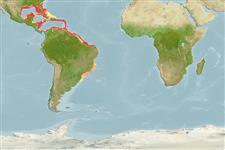>
Perciformes/Serranoidei (Groupers) >
Serranidae (Sea basses: groupers and fairy basslets)
Etymology: Serranus: Latin, serran, serranus, saw and a fish of genus Serranus (Ref. 45335).
Eponymy: Poey calls this species the ‘Serrano Diana’, with Diana being a local name given to the fish in Cuba. [...] (Ref. 128868), visit book page.
More on author: Poey.
Environment: milieu / climate zone / depth range / distribution range
Écologie
marin récifal; profondeur 27 - 400 m (Ref. 47377), usually 27 - 180 m (Ref. 9710). Subtropical; 33°N - 34°S, 98°W - 34°W
Western Atlantic: Bermuda and South Carolina, USA through northeastern Gulf of Mexico and Yucatan, Mexico to southeastern Brazil (Ref. 47377).
Taille / Poids / Âge
Maturity: Lm ? range ? - ? cm
Max length : 20.0 cm TL mâle / non sexé; (Ref. 5217); common length : 15.0 cm TL mâle / non sexé; (Ref. 5217)
Épines dorsales (Total) : 10; Rayons mous dorsaux (Total) : 12; Épines anales: 3; Rayons mous anaux: 7. Body pale brown with 3 vertical dark brown bars; a vertical silver bar just anterior to anus, chest silver; spinous dorsal fin dusky with a black blotch, soft dorsal fin dark brown; pectoral and anal fins dusky; pelvic fin dark brown; caudal fin dusky with upper and lower marginal yellow lines (Ref. 13608).
A solitary species (Ref. 26340) inhabiting rocky areas. Synchronously hermaphroditic. Feed mainly on shrimps, less on crabs and bivalves (Ref. 47377).
Life cycle and mating behavior
Maturité | Reproduction | Frai | Œufs | Fécondité | Larves
Robins, C.R. and G.C. Ray, 1986. A field guide to Atlantic coast fishes of North America. Houghton Mifflin Company, Boston, U.S.A. 354 p. (Ref. 7251)
Statut dans la liste rouge de l'IUCN (Ref. 130435: Version 2024-2)
Menace pour l'homme
Harmless
Utilisations par l'homme
Pêcheries:
Outils
Articles particuliers
Télécharger en XML
Sources Internet
Estimates based on models
Preferred temperature (Ref.
123201): 18 - 27.5, mean 24.7 °C (based on 218 cells).
Phylogenetic diversity index (Ref.
82804): PD
50 = 0.5000 [Uniqueness, from 0.5 = low to 2.0 = high].
Bayesian length-weight: a=0.01096 (0.00518 - 0.02319), b=3.05 (2.88 - 3.22), in cm total length, based on LWR estimates for this Genus-body shape (Ref.
93245).
Niveau trophique (Ref.
69278): 3.5 ±0.50 se; based on food items.
Résilience (Ref.
120179): Milieu, temps minimum de doublement de population : 1,4 à 4,4 années (Preliminary K or Fecundity.).
Fishing Vulnerability (Ref.
59153): Low vulnerability (10 of 100).
Nutrients (Ref.
124155): Calcium = 36.7 [18.7, 91.8] mg/100g; Iron = 0.631 [0.319, 1.174] mg/100g; Protein = 18.9 [17.1, 20.6] %; Omega3 = 0.308 [0.168, 0.535] g/100g; Selenium = 20.2 [9.3, 40.3] μg/100g; VitaminA = 70.4 [21.7, 271.4] μg/100g; Zinc = 0.884 [0.561, 1.400] mg/100g (wet weight);
